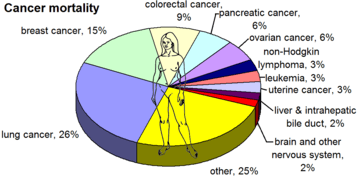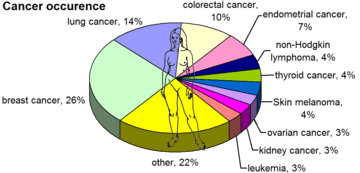Epidemiology of breast cancer

no data
<2
2-4
4-6
6-8
8-10
10-12
|
12-14
14-16
16-18
18-20
20-22
>22
|
Worldwide, breast cancer is the most common invasive cancer in women. (The most common form of cancer is non-invasive non-melanoma skin cancer; non-invasive cancers are generally easily cured, cause very few deaths, and are routinely excluded from cancer statistics.) Breast cancer comprises 22.9% of invasive cancers in women[2] and 16% of all female cancers.[3]
In 2008, breast cancer caused 458,503 deaths worldwide (13.7% of cancer deaths in women and 6.0% of all cancer deaths for men and women together).[2] Lung cancer, the second most common cause of cancer-related death in women, caused 12.8% of cancer deaths in women (18.2% of all cancer deaths for men and women together).[2]
The number of cases worldwide has significantly increased since the 1970s, a phenomenon partly attributed to the modern lifestyles.[4][5]
By age group
Breast cancer is strongly related to age, with only 5% of all breast cancers occurring in women under 40 years old.[6]
By region
The incidence of breast cancer varies greatly around the world: it is lowest in less-developed countries and greatest in the more-developed countries. In the twelve world regions, the annual age-standardized incidence rates per 100,000 women are as follows: in Eastern Asia, 18; South Central Asia, 22; sub-Saharan Africa, 22; South-Eastern Asia, 26; North Africa and Western Asia, 28; South and Central America, 42; Eastern Europe, 49; Southern Europe, 56; Northern Europe, 73; Oceania, 74; Western Europe, 78; and in North America, 90.[7]
United States

The lifetime risk for breast cancer in the United States is usually given as about 1 in 8 (12%) of women by age 95, with a 1 in 35 (3%) chance of dying from breast cancer.[9] This calculation assumes that all women live to at least age 95, except for those who die from breast cancer before age 95.[10] Recent work, using real-world numbers, indicate that the actual risk is probably less than half the theoretical risk.[11]
The United States has the highest annual incidence rates of breast cancer in the world; 128.6 per 100,000 in whites and 112.6 per 100,000 among African Americans.[9][12] It is the second-most common cancer (after skin cancer) and the second-most common cause of cancer death (after lung cancer) in women.[9] In 2007, breast cancer was expected to cause 40,910 deaths in the US (7% of cancer deaths; almost 2% of all deaths).[13] This figure includes 450-500 annual deaths among men out of 2000 cancer cases.[14]
In the US, both incidence and death rates for breast cancer have been declining in the last few years in Native Americans and Alaskan Natives.[13][15] Nevertheless, a US study conducted in 2005 indicated that breast cancer remains the most feared disease,[16] even though heart disease is a much more common cause of death among women.[17] Studies suggest that women overestimate their risk of breast cancer.[18]
UK
Breast cancer is the most common cancer in the UK (around 49,900 women and 350 men were diagnosed with the disease in 2011), and it is the third most common cause of cancer death (around 11,600 women and 75 men died in 2012).[20]
Developing countries
"Breast cancer in less developed countries, such as those in South America, is a major public health issue. It is a leading cause of cancer-related deaths in women in countries such as Argentina, Uruguay, and Brazil. The expected numbers of new cases and deaths due to breast cancer in South America for the year 2001 are approximately 70,000 and 30,000, respectively."[21] However, because of a lack of funding and resources, treatment is not always available to those suffering with breast cancer.
See also
General:
References
- ↑ "WHO Disease and injury country estimates". World Health Organization. 2009. Retrieved Nov 11, 2009.
- ↑ 2.0 2.1 2.2 "World Cancer Report". International Agency for Research on Cancer. 2008. Retrieved 2011-02-26.(cancer statistics often exclude non-melanoma skin cancers such as basal cell carcinoma which though very common are rarely fatal)
- ↑ "Breast cancer: prevention and control". World Health Organization.
- ↑ Laurance, Jeremy (2006-09-29). "Breast cancer cases rise 80% since Seventies". The Independent (London). Retrieved 2006-10-09.
- ↑ "Breast Cancer: Statistics on Incidence, Survival, and Screening". Imaginis Corporation. 2006. Retrieved 2006-10-09.
- ↑ Breast Cancer: Breast Cancer in Young Women WebMD. Retrieved on September 9, 2009
- ↑ B. W. and Kleihues P. (Eds): World Cancer Report. IARCPress. Lyon 2003
- ↑ 8.0 8.1 Jemal A, Siegel R, Ward E et al. (2008). "Cancer statistics, 2008". CA Cancer J Clin 58 (2): 71–96. doi:10.3322/CA.2007.0010. PMID 18287387.
- ↑ 9.0 9.1 9.2 American Cancer Society (September 13, 2007). "What Are the Key Statistics for Breast Cancer?". Archived from the original on January 5, 2008. Retrieved 2008-02-03.
- ↑ Olson, 2002. pages 199–200.
- ↑ W.B. Cutler, R.E. Burki, E. Genovesse, M.G. Zacher (September 2009). "Breast cancer in postmenopausal women: what is the real risk?". Fertility and Sterility 92 (3): S16. doi:10.1016/j.fertnstert.2009.07.061. PMID 123455.
- ↑ "Browse the SEER Cancer Statistics Review 1975–2006".
- ↑ 13.0 13.1 American Cancer Society (2007). "Cancer Facts & Figures 2007" (PDF). Archived from the original on April 10, 2007. Retrieved 2007-04-26.
- ↑ "Male Breast Cancer Causes, Risk Factors for Men, Symptoms and Treatment on". Medicinenet.com. Retrieved 2010-05-08.
- ↑ Espey DK, Wu XC, Swan J, et al. (2007). "Annual report to the nation on the status of cancer, 1975–2004, featuring cancer in American Indians and Alaska Natives". Cancer 110 (10): 2119–52. doi:10.1002/cncr.23044. PMID 17939129.
- ↑ "Women's Fear of Heart Disease Has Almost Doubled in Three Years, But Breast Cancer Remains Most Feared Disease" (Press release). Society for Women's Health Research. 2005-07-07. Retrieved 2007-10-15.
- ↑ "Leading Causes of Death for American Women 2004" (PDF). National Heart Lung and Blood Institute. Retrieved 2007-10-15.
- ↑ In Breast Cancer Data, Hope, Fear and Confusion, By DENISE GRADY, New York Times, January 26, 1999.
- ↑ chart for Figure 1.1: Breast Cancer (C50), Average Number of New Cases per Year and Age-Specific Incidence Rates, UK, 2006-2008 at Breast cancer - UK incidence statistics at Cancer Research UK. Section updated 18/07/11.
- ↑ "Breast cancer statistics". Cancer Research UK. Retrieved 27 October 2014.
- ↑ (Schwartzmann, 2001, p 118)

